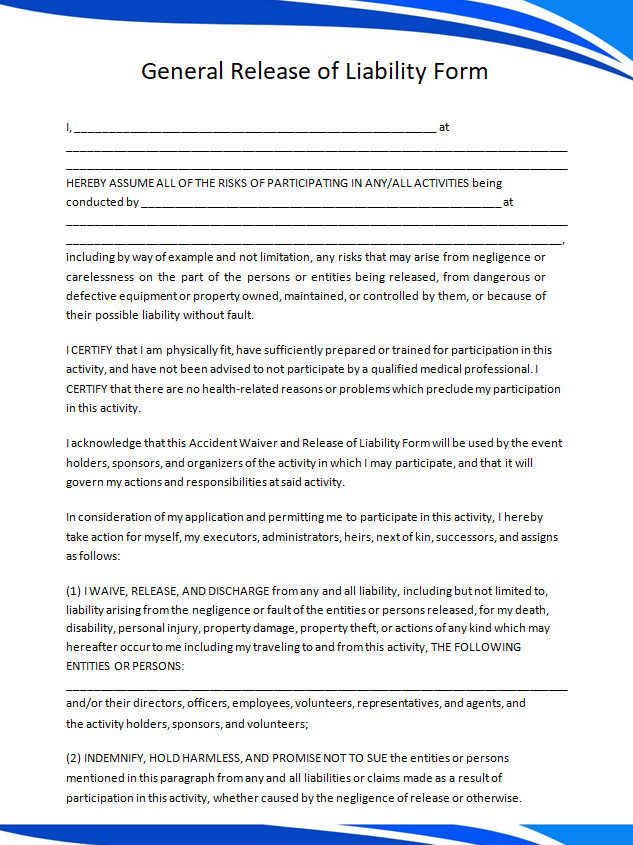
What is a Release of Liability Form?
A release of liability form, commonly known as a waiver or exculpatory agreement, is a legal document that serves as a contract between two parties involved in an activity or service. The releasor, also known as the participant, acknowledges and assumes certain inherent risks associated with the activity provided by the releasee, who is typically the host.
By signing the form, the releasor agrees to waive their right to legal action for any potential injuries, damages, or losses that may occur during the course of the activity.
Benefits of Release of Liability Forms
Release of liability forms offer several benefits for both participants and hosts involved in activities or services with inherent risks. Some of the key benefits include:
- Clear Communication: The form clearly outlines the risks involved in the activity, ensuring that participants are aware of potential dangers.
- Legal Protection: By signing the form, participants waive their right to sue the host for injuries or damages, providing legal protection for the host.
- Peace of Mind: Participants can engage in the activity with peace of mind, knowing that they have acknowledged and assumed the risks involved.
When to Use a Release Form?
Release of liability forms should be utilized in any situation where there is a potential risk of harm or injury to participants. These forms are commonly used in various scenarios, including:
- Organized Events: Sporting events, fitness classes, and adventure activities where accidents can happen.
- Property Rentals: Renting out a property for events or gatherings where guests may be injured.
- Professional Services: Providing services that carry risks, such as medical treatments or construction work.
- Recreational Activities: Any recreational activities like hiking, skiing, or swimming where injuries may occur.
- Volunteer Work: Engaging in volunteer work where there is a risk of accidents or injuries.
Specific Use Cases
Release of liability forms can be tailored to specific activities or services to address unique risks and considerations. Some specific use cases where customized release forms are commonly used include:
- Adventure Tourism: Companies offering adventurous activities such as zip-lining, bungee jumping, or white-water rafting often require participants to sign detailed release forms due to the inherent risks involved.
- Sports Events: Athletes participating in organized sports events or competitions are typically required to sign sports liability waivers to acknowledge the risks associated with the sport.
- Childcare Services: Parents enrolling their children in daycare or childcare services may be asked to sign release forms to indemnify the service provider from liability in case of accidents or injuries.
Components of a General Release of Liability Form
A general release of liability form typically contains several key components to ensure clarity and enforceability. These components include:
- Identifying Information: Names, addresses, and contact details of the releasor and releasee.
- Description of Activity: Details of the activity or service being provided, including any potential risks involved.
- Risks and Assumptions: Explanation of the inherent risks associated with the activity and the releasor’s acknowledgment of those risks.
- Release of Liability: Clear language waiving the releasor’s right to legal action for any injuries or damages that may occur during the activity.
- Signatures: Signatures of both parties to indicate agreement to the terms outlined in the form.
Drafting a Comprehensive Release Form
When drafting a release of liability form, it is essential to ensure that all necessary elements are included to protect both parties involved. Here are some tips for creating a comprehensive release form:
- Consult Legal Counsel: Seek advice from a legal professional specializing in liability waivers to ensure that the form complies with local laws and regulations.
- Include Specific Risks: Clearly outline the specific risks associated with the activity or service to ensure that participants are fully informed.
- Use Clear Language: Avoid legal jargon and use plain language to ensure that participants understand the terms of the waiver.
- Review and Update Regularly: Periodically review and update the release form to reflect any changes in the activity or service provided.
- Obtain Consent: Ensure that participants read and understand the terms of the waiver before signing to demonstrate informed consent.
Legal Considerations
While release of liability forms are valuable tools for managing risk and protecting both parties from legal action, there are some legal considerations to keep in mind:
- State-Specific Laws: Laws governing liability waivers may vary by state, so it is important to be aware of the specific regulations in your jurisdiction.
- Unenforceable Terms: Certain terms in a release form may be deemed unenforceable if they violate public policy or are unconscionable. It is crucial to ensure that the terms are fair and reasonable.
- Inherent Risks: While waivers can protect hosts from negligence claims, they may not cover injuries resulting from intentional acts or gross negligence. Hosts should still take reasonable precautions to ensure the safety of participants.
General Release of Liability Form Template
A general release of liability form is a crucial document that safeguards individuals or organizations against future claims or legal disputes. It outlines the agreement that one party will not hold the other responsible for potential risks, damages, or injuries related to an activity or situation.
To ensure clarity and protection for both sides, use our free general release of liability form and create a professional agreement with ease!
General Release of Liability Form – Word